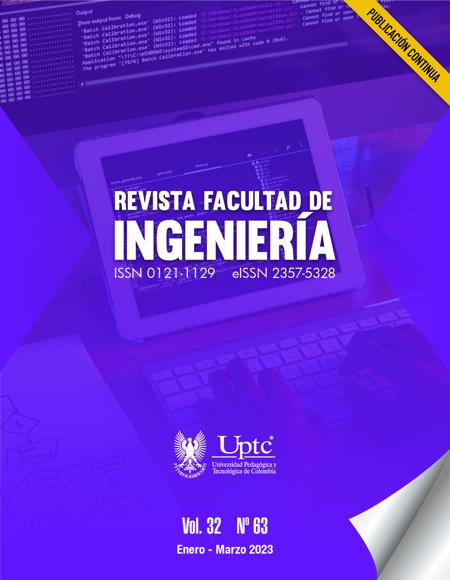Metodología para la elaboración de análisis de patentes y ciclo de madurez tecnológica

Resumen
El análisis de patentes y el comportamiento de la tecnología en el tiempo han despertado un gran interés en las instituciones y compañías debido a que sirve como una guía en la toma de decisiones sobre proyectos de investigación e innovación. Basados en lo anterior, una metodología que busca guiar al lector en la elaboración de este tipo de estudios, tanto el cuerpo del documento como su interpretación. Se utilizaron dos softwares para describir la extracción de datos de patentes Orbit Intelligence (Software licenciado) y Lens (Versión de acceso libre) y se presentó la información obtenida a partir del uso de la ecuación de búsqueda. Para el análisis del ciclo de madurez tecnológica se utilizó el modelo logístico y se ejecutó en el algoritmo Loglet Lab 4 para obtener la curva de crecimiento S. Finalmente, se proponen los parámetros de Yoon para dar un concepto predictivo del comportamiento de la tecnología en el tiempo. El caso de estudio que se tomó como ejemplo fue la tecnología de “Superficies antibacteriales y autolimpiantes a base TiO2/ZnO”. Al aplicar esta metodología, se encontró que la fase de madurez en la que se encuentra la tecnología de interés sugiere un alto impacto en el mercado. Este indicador importante para la toma de decisiones enfocadas a la investigación y desarrollo. De acuerdo con lo planteado, la metodología expuesta es una herramienta que permite presentar un concepto más acertado sobre las proyecciones futuras de una tecnología, basadas en el análisis de datos de patentes. No obstante, es importante tener en cuenta las tendencias del mercado y la situación sociopolítica.
Palabras clave
predicciones, orbit, analisis de patentes, ciclo de vida tecnologico
Citas
- S. Sinisterra, R. Camargo-Amado, D. Triviño, F. Machuca Martínez, "Análisis del Ciclo de Madurez Tecnológica de Superficies Antibacterianas y Autolimpiantes a base de TiO2/ZnO," Ciencia en desarrollo, vol. 13, no. 1, pp. 115–127, 2022. https://doi.org/10.19053/01217488.v13.n1.2022.13590 DOI: https://doi.org/10.19053/01217488.v13.n1.2022.13590
- F. Machuca-Martinez, R. Camargo, O. Gutierrez, "Coronaviruses: A patent dataset report for research and development (R&D) analysis," Data in Brief, vol. 30, e105551, 2020. https://doi.org/10.1016/j.dib.2020.105551 DOI: https://doi.org/10.1016/j.dib.2020.105551
- J. Sheau-Pyng, L. Ming-Fong, F. Chin-Yuan, “Using Patent Analysis to Analyze the Technological Developments of Virtualization,” Procedia - Social and Behav. Sciences., vol. 57, pp. 146–154, 2012. https://doi.org/10.1016/j.sbspro.2012.09.1168 DOI: https://doi.org/10.1016/j.sbspro.2012.09.1168
- D. Kochetkov, M. Almaganbetov, "Using patent landscapes for technology benchmarking: A case of 5g networks," Advances in Systems Science and Applications, vol. 21, no. 2, pp. 20-28, 2021. https://doi.org/10.25728/assa.2021.21.2.988
- G. Mao, H. Hu, X. Liu, J. Crittenden, N. Huang, “A bibliometric analysis of industrial wastewater treatments from 1998 to 2019,” Environmental Pollution, vol. 275, e115785, 2021. https://doi.org/10.1016/j.envpol.2020.115785 DOI: https://doi.org/10.1016/j.envpol.2020.115785
- M. Nagula, "Forecasting of Fuel cell technology in hybrid and electric vehicles using Gompertz growth curve," Journal of Statistics and Management Systems, vol. 19, no. 1, pp. 73-88, 2016. https://doi.org/10.1080/09720510.2014.1001601 DOI: https://doi.org/10.1080/09720510.2014.1001601
- J. Yoon, B. Jeong, W. H. Lee, J. Kim, “Tracing the Evolving Trends in Electronic Skin (e-Skin) Technology Using Growth Curve and Technology Position-Based Patent Bibliometrics,” IEEE Access, vol. 6, pp. 26530–26542, 2018. https://doi.org/10.1109/ACCESS.2018.2834160 DOI: https://doi.org/10.1109/ACCESS.2018.2834160
- M. E. Leitch, E. Casman, G. V. Lowry, “Nanotechnology patenting trends through an environmental lens: Analysis of materials and applications,” Journal of Nanoparticle Research, vol. 14, e1283, 2012. https://doi.org/10.1007/s11051-012-1283-9 DOI: https://doi.org/10.1007/s11051-012-1283-9
- M. M. H. Bellido, H. L. Mendonça, M. V. de A. Fonseca, D. A. C. Branco, A. O. Pereira, “Maturity-based analysis of emerging technologies in the Brazilian Power Sector,” Journal of Cleaning Production, vol. 243, e118603, 2020. https://doi.org/10.1016/j.jclepro.2019.118603 DOI: https://doi.org/10.1016/j.jclepro.2019.118603
- X. Wu, “Application of Logistic Model in City Development Forecast,” in 2nd International Conference on Material Science, Machinery and Energy Engineering, 2017, pp. 706–710. https://doi.org/10.2991/msmee-17.2017.137 DOI: https://doi.org/10.2991/msmee-17.2017.137
- Y. H. Tseng, C. J. Lin, Y. I. Lin, “Text mining techniques for patent analysis,” Information Processing and Management, vol. 43, no. 5, pp. 1216–1247, 2007. https://doi.org/10.1016/j.ipm.2006.11.011 DOI: https://doi.org/10.1016/j.ipm.2006.11.011
- A. Trippe, Guidelines for Preparing Patent Landscape Reports Guidelines prepared for the World Intellectual Property Organization (WIPO) With contributions from WIPO Secretariat, 2015. http://www.wipo.int/tisc/en/
- Elsevier, 11 steps to structuring a science paper editors will take seriously, 2022. https://www.elsevier.com/connect/11-steps-to-structuring-a-science-paper-editors-will-take-seriously
- LogletLab4, Documentation Loglet Lab4, 2021. https://logletlab.com/loglet/documentation/index
- Lens, Support Center, 2021. https://support.lens.org/help-resources/search/scholarly-search/
- WIPO, Patentes, 2022. https://www.wipo.int/patents/es/
- B. Degroote, P. Held, “Analysis of the patent documentation coverage of the CPC in comparison with the IPC with a focus on Asian documentation,” World Patent Information, vol. 54, pp. S78–S84, 2018. https://doi.org/10.1016/j.wpi.2017.10.001 DOI: https://doi.org/10.1016/j.wpi.2017.10.001
- H. Ernst, “The Use of Patent Data for Technological Forecasting: The Diffusion of CNC-Technology in the Machine Tool Industry,” Small Business Economics, vol. 9, no. 4, pp. 361–381, 1997. https://doi.org/10.1023/A:1007921808138 DOI: https://doi.org/10.1023/A:1007921808138
- P. S. Meyer, J. W. Yung, J. H. Ausubel, “A Primer on Logistic Growth and Substitution: The Mathematics of the Loglet Lab Software,” Technological Forecasting and Social Change, vol. 61, no. 3, pp. 247–271, 1999. https://doi.org/10.1016/s0040-1625(99)00021-9 DOI: https://doi.org/10.1016/S0040-1625(99)00021-9
- L. Gao et al., “Technology life cycle analysis method based on patent documents,” Technological Forecasting and Social Change, vol. 80, no. 3, pp. 398–407, 2013. https://doi.org/10.1016/j.techfore.2012.10.003 DOI: https://doi.org/10.1016/j.techfore.2012.10.003
- M. Baumann et al., “Comparative patent analysis for the identification of global research trends for the case of battery storage, hydrogen and bioenergy,” Technological Forecasting Social Change, vol. 165, e120505, 2021. https://doi.org/10.1016/j.techfore.2020.120505 DOI: https://doi.org/10.1016/j.techfore.2020.120505
- J. Yoon, Y. Park, M. Kim, J. Lee, D. Lee, “Tracing evolving trends in printed electronics using patent information,” Journal of Nanoparticle Research, vol. 16, no. 7, e2471, 2014. https://doi.org/10.1007/s11051-014-2471-6 DOI: https://doi.org/10.1007/s11051-014-2471-6
- O. A. Jefferson et al., “Erratum: Mapping the global influence of published research on industry and innovation,” Nature Biotechnology, vol. 36, no. 8, p. 772, 2018. https://doi.org/10.1038/nbt0818-772a DOI: https://doi.org/10.1038/nbt0818-772a